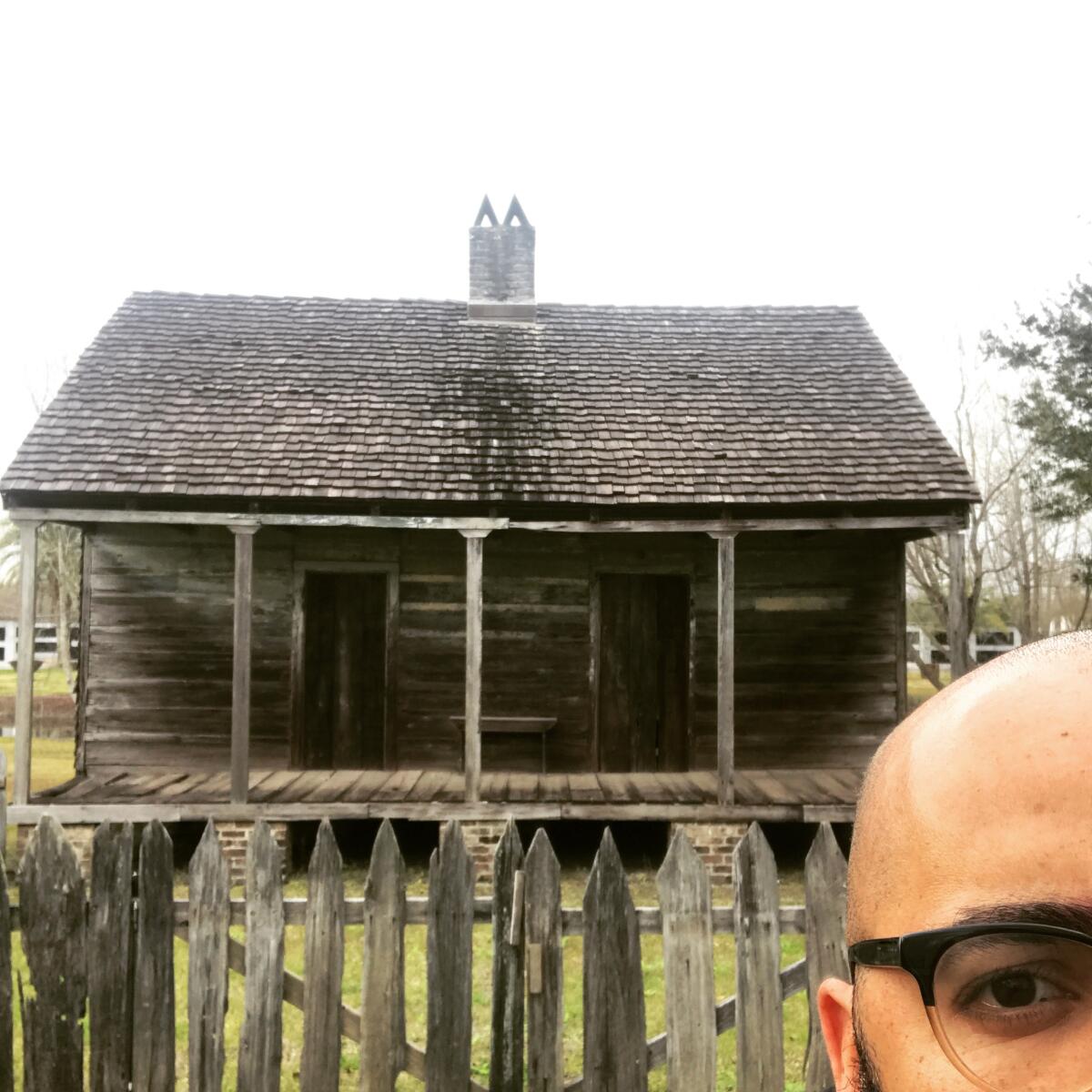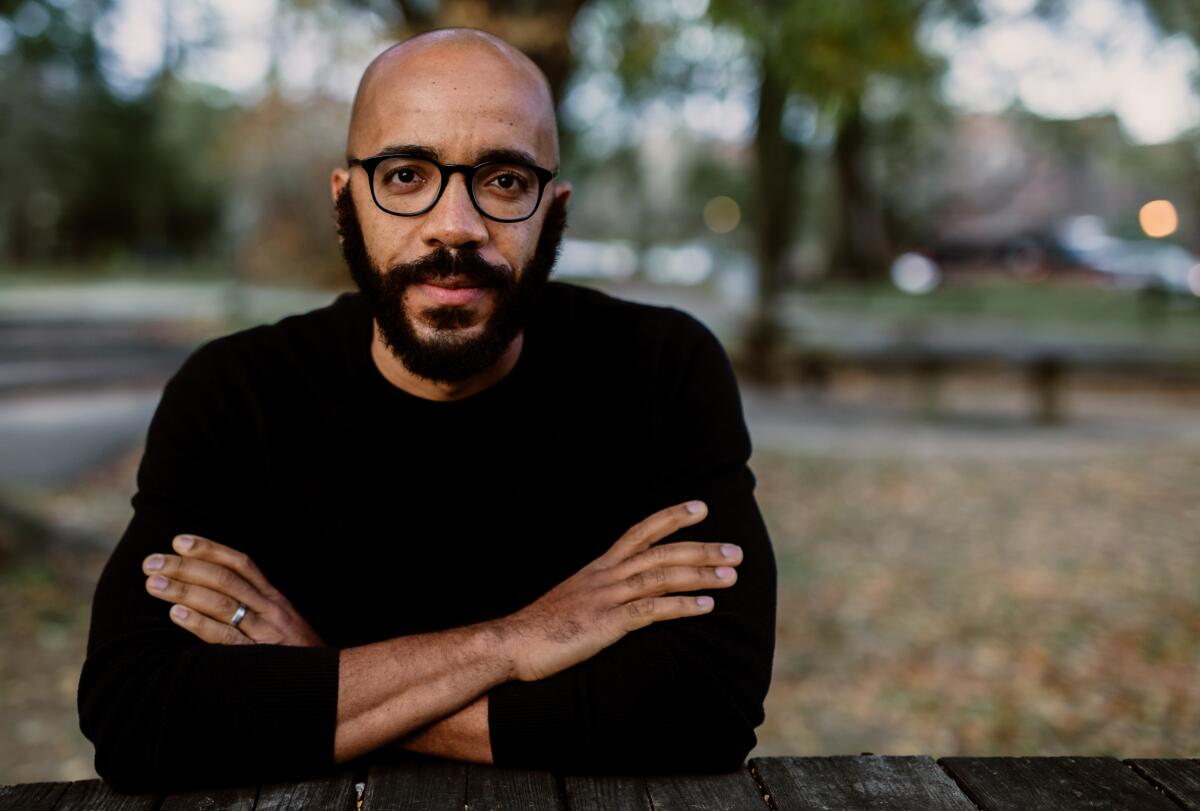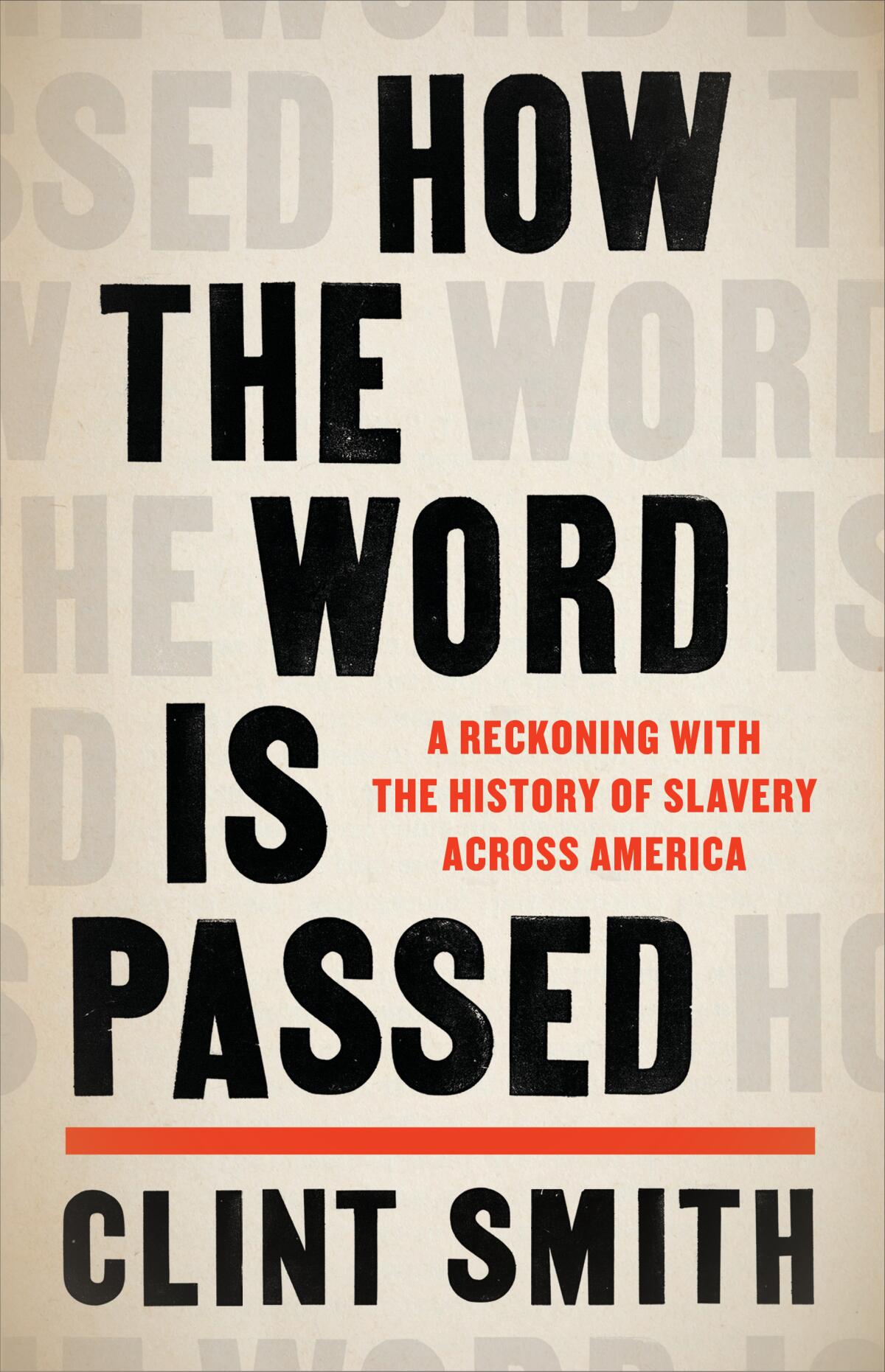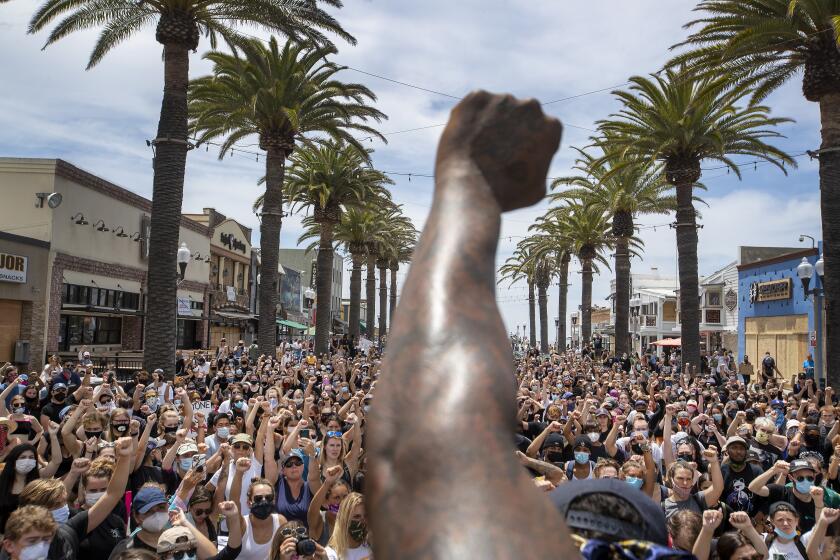When will America finally dismantle its racist myths? Two powerful new books try

On the Shelf
Myths and Monuments
How the Word is Passed
By Clint Smith
Little, Brown: 352 pages, $29
Forget the Alamo: The Rise and Fall of An American Myth
By Bryan Burrough, Chris Tomlinson and Jason Stanford
Penguin: 416 pages, $32
If you buy books linked on our site, The Times may earn a commission from Bookshop.org, whose fees support independent bookstores.
The 2015 massacre at a Black church in South Carolina, the 2017 white supremacist rally in Virginia and the murder of George Floyd last year in Minnesota each spurred an effort to dismantle the lingering stench of the Confederacy. After every tragedy came a wave of removals of flags, monuments and signs across the South. But these were small steps, and two powerful new books, “How the Word Is Passed” and “Forget the Alamo,” make the case for giant leaps: major rethinking and revisions of the way public schools and tourist sites present our deeply flawed history.
“When I visited plantations on field trips with school as a kid, they only talked about the beauty of the house and the fine china,” recalls Clint Smith, the author of “How the Word Is Passed” who grew up in New Orleans near Robert E. Lee Boulevard and Jefferson Davis Highway. In one history class, “seceding from the Union was talked about in terms of states’ rights and taxes. No one mentioned slavery.”
The echoes of those experiences, along with more recent events, inspired Smith’s book. He visits Thomas Jefferson’s Monticello and lesser-known sites like the Whitney Plantation, Blandford Cemetery and Angola Prison to examine how each presents — or ignores — its deep connection to slavery and the implications for America’s understanding of itself.
Scott Ellsworth talks about ‘The Ground Breaking,’ a new follow-up to ‘Death in a Promised Land,’ his pioneering 1982 exposé of atrocities in Tulsa.
Smith traces this willful forgetting to the Lost Cause, the wildly successful Southern whitewashing of the Civil War that has Confederates fighting for freedom as opposed to slavery. He still sees it in the way some white people, who thrill to a parade of World War II movies, moan “there they go again” when a series like Barry Jenkins’ “Underground Railroad” takes center stage.
“We don’t have enough public conversations about slavery,” Smith says, “We had slavery for 250 years and have only not had it for about 150. And the residue has shaped every part of our social, political and economic infrastructure, like redlining, Jim Crow and mass incarceration. To suggest that this history has nothing to do with our contemporary inequality is morally and intellectually disingenuous.”

Bryan Burrough, Chris Tomlinson and Jason Stanford have also resurrected a long-suppressed slavery saga in “Forget the Alamo.” Home to one of America’s most famous battles, the Alamo is sacred ground for white Texans and central to the Lone Star State’s grandiose origin story — another “Lost Cause.” As a founding myth that belongs to the whole country, it is long overdue for reassessment. “It’s one thing to remove a statue of Jefferson Davis, but this is a national monument on the level of Gettysburg,” Burrough says.
The authors argue that Texas middle school students have long received a warped version of history: William Travis, Jim Bowie and Davey Crockett were unadulterated heroes who bravely fought to the death against Santa Anna and the other bad hombres. That’s wildly inaccurate and woefully incomplete.
There is the neglected role of the Tejanos, Mexicans living in the region. But “the most surprising thing we found,” Burrough says, “was the centrality of slavery to the revolt.” The one constant in Stephen Austin’s negotiations with Mexico was his insistence on slavery, something abolitionist Mexico steadfastly resisted.
“That’s difficult for Americans, who’ve grown up seeing Mexico as this backward, corrupt country to realize,” says Burrough, “that Mexico had the moral high ground.”
Former U.S. Poet Laureate Natasha Trethewey always wrote of public pain and private struggle. Her memoir, ‘Memorial Drive,’ lets her mother speak.
“Forget the Alamo” punctures numerous misconceptions and explores the insidious ways they penetrated popular culture, from Disney’s “Davy Crockett” in the 1950s to John Wayne’s “The Alamo” in 1960 and far beyond.
“By and large, even as a sweeping reassessment of the country’s racial past has begun within the Confederate milieu, Texas has gotten a pass,” Burrough says. “That’s strange given that we’re standing on about 30 years of academic reassessment of the Alamo and the Texas Creation Myth. Almost none of it has seeped into the mainstream discourse. With Latinos poised to be a majority in Texas, it’s past time for there to be a constructive debate about what it all means.”

Both these books are measured in their indignation, but they differ in their approach. “Forget the Alamo” is written as traditional reporting and analysis of the underlying causes, the “heroes” and the battle itself, with some flashes of humor and steel.
“Bowie was a murderer, slaver, and con man,” the authors write. “Travis was a pompous, racist agitator and syphilitic lech; and Crockett was a self-promoting old fool who was captive to his own myth. ... They fought for freedom, just not everybody’s freedom.”
The authors also recount the battle to tell the story, revealing how numerous politicians, most recently George P. Bush, have capitulated to public (read: white) pressure and reverted to the “Heroic Anglo Narrative.” And for good measure, they shred the pack of lies surrounding the fraudulent Alamo artifacts bought by rock legend Phil Collins — a dubious collection that inspired Texas to spend taxpayers’ millions to build a fancy new museum.
While “Forget the Alamo” is an in-depth investigation into a quintessentially American myth, “How the Word Is Passed” roams disparate sites across not just the South but also New York — to show how complicit the North was in pursuit of profit — and even Africa. Stop by stop, Smith weaves a tapestry of willful ignorance before pointing the way toward improvement.
He exposes the falsehoods still being peddled in places like Angola, the notorious Louisiana prison and former plantation with a museum and tour that “not only seems to be indifferent to the history of the place but which seems to make a mockery of it.”
At Blandford, he discovers a Confederate cemetery that boasts of Tiffany windows honoring the valor of its soldiers, as well as a Memorial Day commemoration rife with hypocrisy and distortions. (Speakers argued that Confederate soldiers — killers of Americans — should be honored as American veterans.)

Smith’s book is more intimate in tone than “Forget the Alamo.” While facts and interviews with scholars ground his work, the emotional texture comes through conversations with ordinary folks visiting the sites. He also deftly uses sensory details, as when putting the reader with him inside a plantation cabin, “listening to a creak of the floor and thinking how the board must have groaned under the bodies of the people with no choice but to sleep directly on it.”
Smith unearths signs of progress as well. Monticello has evolved in telling its story; the Whitney Plantation was founded on the premise that plantation tours should be about the evil of slavery and not big-house beauty. A chapter on the roots and current meaning of the annual Juneteenth celebration in Galveston, Texas, is downright joyful in parts.
In travel writer Richard Grant’s “The Deepest South of All,” Natchez, Miss., is full of characters, stubborn racist traditions and lots of contradictions.
The two histories aim for different readers. Burrough says changing the way Texans think means getting the government to change how it teaches students. Right now, Alamo tall tales stand in for reality because the largely Anglo elite ignores the Latino perspective without fear of repercussions. “We wrote this hoping, perhaps naively, that there are thinking people in the state’s power structure and media that just hadn’t given this a lot of thought.”
Smith agrees on revising education. “It’s important we start young,” he says. “Right now we’re asking young people to unlearn so much stuff they’ve learned. Why not just teach them the right thing from the beginning?”
Yet his target isn’t people in power. He wrote the book he’d have wanted both as a high-school teacher and as a teen himself. “When I learned the history of this country in earnest, which didn’t truly happen until graduate school, it was so profoundly freeing,” he says. “It was emancipatory because I realized that so much of what this country has told you about people who look like you is not true. Back then I would have wanted something that gave me the ability to name and understand so many of the lies this country has told me.”

Even as “the waters are rising on reassessing the past,” as Burrough puts it, the forces of reaction are lashing back. “There are people here that say even raising questions about the Alamo means you’re trying to bring down the government,” he says.
Indeed, states like Texas and Oklahoma are scrambling to reverse the tide, passing bills legislating against new analysis of slavery and racism in their schools. The irony of publishing books in this environment is not lost on the authors.
Walter Mosley, Luis Rodriguez, the coiner of #BlackLivesMatter and others sketch a hopeful future for L.A. and the U.S. after George Floyd protests.
“State legislation against critical race theory is a new iteration of the Lost Cause,” Smith says. “The insidiousness of white supremacy and racism is that it takes an empirical statement and turns it into an ideological one. If I say, ‘The Confederacy was a treasonous army predicated on maintaining and expanding the institution of slavery,’ some white people interpret that as being reflective of my ideological disposition and politics. In fact, it’s just what’s on the historical record. Say that in your classroom and you’re seen to be doing something radical and political.”
And so for all the incremental progress, there is still no broader reckoning with the facts, as there was in Germany after World War II. Without it, Smith finds it difficult to hold out hope for systemic change. Understanding the past can enable us to decide “what policy needs to be created to repair the harm,” Smith says. “And we still have a ways to go.”
More to Read
Sign up for our Book Club newsletter
Get the latest news, events and more from the Los Angeles Times Book Club, and help us get L.A. reading and talking.
You may occasionally receive promotional content from the Los Angeles Times.








